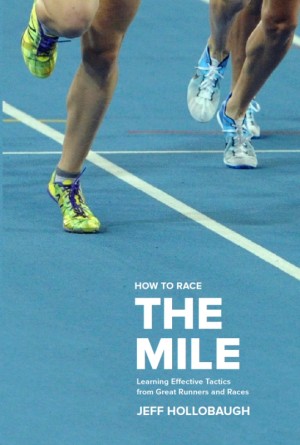Book Review: “How to Race the Mile” by Jeff Hollobaugh – “A terrific resource for younger runners” and “also a great read for even the expert fan”
“It’s a rich resource for the hardcore track and field nerd as well as the novice runner.”
By Jonathan Gault
August 8, 2015
 You can order a copy of How to Race the Mile here
You can order a copy of How to Race the Mile here
If, like me, you’re a track nerd, you know that most of the time the story of a distance race can’t be distilled down to a simple results page. In the field events, athletes compete against one another, but in reality, they’re competing against an obstacle. How far can I jump while taking off before this line? How high can I jump over this bar? In the high jump and pole vault, strategy can come into play as athletes decide which heights to pass, but that strategy can be summarized neatly in the results at the end of the competition. Even in sprint races, athletes don’t have to worry about the competition nearly as much as their own bodies. Because sprint races are run in lanes, an athlete’s tactics can be entirely devised prior to to the race: whatever strategy enables them to get to the finish line fastest is the best one, as sprinters cannot limit the speed of their competitors.
A distance race is a different beast. Every competitor shares the same track, and the decisions one athlete make during a race can have a major impact on how others run. It’s a fluid ecosystem; race dynamics are constantly changing.
Veteran track and field journalist Jeff Hollobaugh has long been fascinated by the how and why of races, particularly when it comes to his favorite event, the 1500/mile.
“You’re seeing the match of strength and endurance with brain power,” Hollobaugh said. “Mistakes count for a lot there. Fitness isn’t the only thing, whereas in the 10,000 meters, especially a championship one, you’ll see great tactics, but in the end, more so than in the 1500, fitness wins.”
So after writing his first book, The 100 Greatest Track & Field Battles of the 20th Century, in 2012, Hollobaugh sought to create a work that dove into the nitty-gritty of tactics: what it takes to win at the highest level. Narrowing his focus to the 1500/mile was a natural choice. The event has long been the most fabled among the distance races. At four laps, it’s long enough for a narrative to develop and short enough to retain the attention of the casual fan.
The result, How to Race the Mile: Learning Effective Tactics from Great Runners and Races, is a comprehensive look at the event from the 19th century to the present. Drawing on over 50 races from the professional and collegiate ranks, Hollobaugh dedicates each chapter to a specific style of race (chapter titles include “Successful Front-Running” and “The Long Kick”), beginning each chapter with a brief background on each style. But the jewel of the book is its race histories, in which Hollobaugh breaks down great races from the past with insight from the key players. Hollobaugh leads the reader on a journey through each race, pausing to impart lessons from the greats at the race’s critical moment. Each chapter concludes with nuggets of wisdom from top athletes and coaches, some of which, such as Renato Canova‘s discussion of the difference between Bernard Lagat‘s “speed for the kick” and Silas Kiplagat‘s “high speed endurance,” is truly insightful.
Hollobaugh does a good job outlining the benefits and drawbacks of each strategy, which makes the book a terrific resource for younger runners still learning how to run the event. But it’s also a great read for even the expert fan, as it’s a treat to hear runners explain their thought process in famous races. Former world champion Jenny Simpson, in particular, was very forthcoming and showed a great deal of introspection in discussing her most famous races. Her insights (and those of other athletes), such as how she decided to control the 2013 World Championship final from the front after reluctantly finding herself in the lead, really carry the book.
Though the athlete commentary is one of How to Race the Mile‘s strengths, it’s also the book’s greatest weakness, in that it can occasionally drag on too long. Sometimes at the end of chapters, two athletes will offer a similar piece of advice. Other times, it can get tedious reading through block quote after block quote (Chapter 13 consists solely of 38 pages of athlete quotes).
Hollobaugh also sprinkles his own insights throughout and is strongly in favor of racing for place, rather than time. “I maintain that if you need a clock to tell you that you just watched a good race, it wasn’t much of a race,” Hollobaugh writes, and as a result, most of the races discussed are championship finals (Hicham El Guerrouj‘s 1500/mile world record efforts are notably absent).
Overall, it’s a rich resource for the hardcore track and field nerd as well as the novice runner. Older fans can look back on classic races with a fresh perspective, while younger runners can experience those races — and learn their lessons — for the first time.
Want to order a copy? You can buy one off Amazon here or request a signed copy from Hollobaugh through howtoracethemile.com.
Other book reviews by LetsRun.com can be found here.







